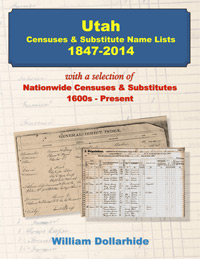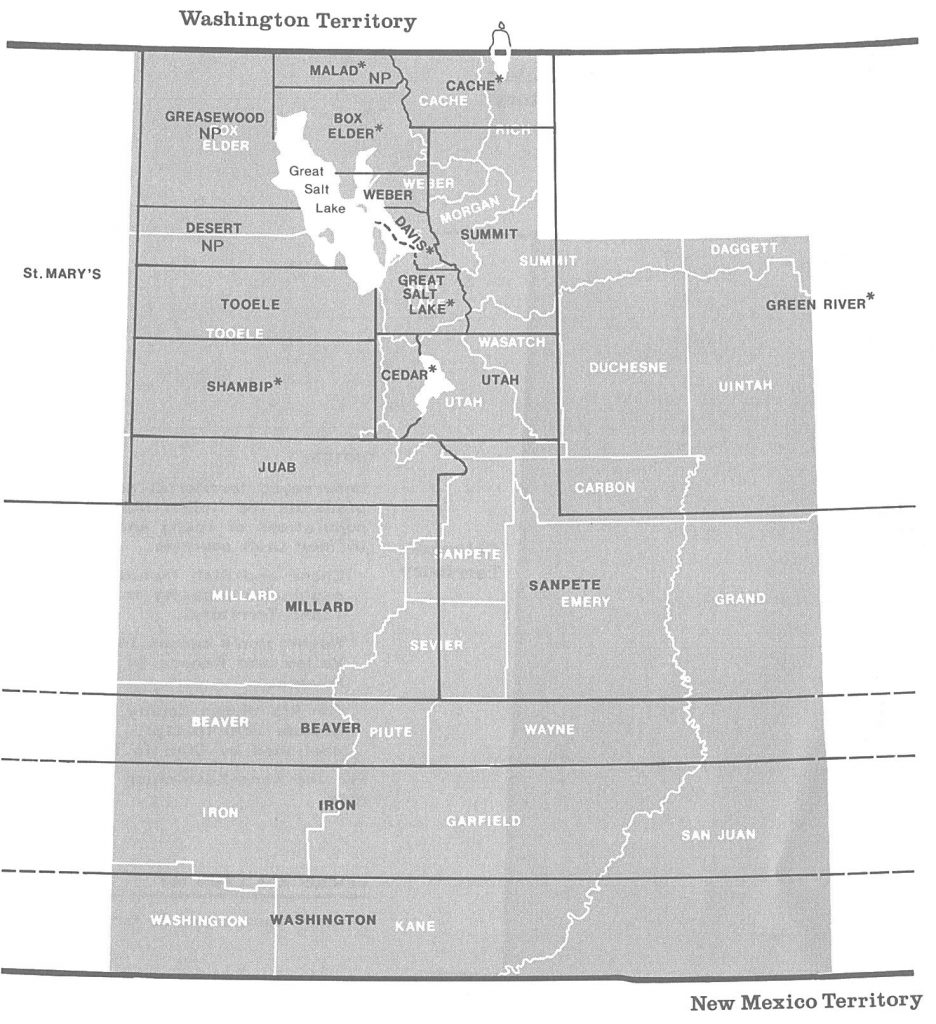The following article is by my friend Bill Dollarhide, taken from his book, Utah Censuses & Substitute Name Lists, 1847-2014.
 Prologue: Had there been no Mexican War in 1846, there would probably not have been an American territory of Utah. At their 1846 winter quarters in Council Bluffs, Iowa, Brigham Young met with representatives of President James Polk, and agreed to supply a battalion of troops to march to San Diego and secure Alta California for the U.S. That agreement tied the Mormons to the U.S. thereafter. The events leading up to the Mormon migration to Utah and their struggles to become a U.S. State are shown below.
Prologue: Had there been no Mexican War in 1846, there would probably not have been an American territory of Utah. At their 1846 winter quarters in Council Bluffs, Iowa, Brigham Young met with representatives of President James Polk, and agreed to supply a battalion of troops to march to San Diego and secure Alta California for the U.S. That agreement tied the Mormons to the U.S. thereafter. The events leading up to the Mormon migration to Utah and their struggles to become a U.S. State are shown below.
1776. Fathers Silvestre Velez de Escalante and Francisco Atanasio Dominguez searched for a new route from Santa Fe to the missions in California. They were the first Europeans to explore present Utah.
1819. A Spanish-American treaty set the boundary between the Louisiana Purchase/Western U.S. region and Spanish claims, which placed present Utah entirely within Spanish Mexico.
1821. Mexico won independence from Spain and reaffirmed the Spanish-American treaty boundaries of 1819 which included all of Utah, now part of Alta California, Mexico.
1824. General William H. Ashley’s American Fur Company sent fur traders to northern Utah. One of them, Jim Bridger, discovered the Great Salt Lake.
1826. Jedediah Smith led the first overland expedition to California via present northern Utah.
1832. Antoine Robidoux established a trading post in the Uintah region of present Utah.
1841. Capt. John Bartleson led the first wagon train of settlers from Missouri to California. The route they followed became the northern Utah section of the California Trail.
1843. John C. Fremont and Kit Carson explored the basin of the Great Salt Lake.
1846. The first group of Mormons from Nauvoo, Illinois left on their trek to Utah. Brigham Young’s stated goal was to establish a “State of Deseret” in an uninhabited part of Mexico.
1846. At the Mormon winter camp at Council Bluffs, Iowa, Brigham Young agreed to provide the U.S. Army with a battalion of 500 men, with orders to march on San Diego and secure it for the United States. Wages for the Mormon soldiers were paid in advance in gold, and helped finance the main party’s trip west. This act of support for the United States with the Mormon Battalion and their involvement in the Mexican-American war, was what obligated the Mormons to remain in the U.S. thereafter.
1847. The first parties of Mormon pioneers arrived in the Salt Lake Valley. It was the largest single migration group in American history. Over the next twenty years, as many as 50,000 would follow the Mormon Trail to Utah. For their first year in the Salt Lake area, the Mormons laid claim to lands in the name of the United States, but the area was still part of Mexico.
1848. The Treaty of Guadalupe Hidalgo ended the war with Mexico. In the Mexican Cession of 1848, Utah was annexed to the United States, within an area that included present California, Nevada, Utah, New Mexico, and parts of Colorado and Wyoming..
1849. The first Constitutional Convention in Salt Lake proposed the State of Deseret which would encompass the region from the Continental Divide to California between Oregon Territory and New Mexico Territory.
1850. In September, the U.S. Congress rejected statehood for Deseret, but established Utah Territory, encompassing the same region as earlier proposed for Deseret. Brigham Young was appointed the territorial Governor.
– Also in 1850, the University of Deseret (later University of Utah) was chartered.
– The Deseret News started in June.
1851. Apr. The 1850 Federal Census for Utah Territory was taken with a census day of April 1, 1851. The population was 11,380. Hundreds of the original pioneers had already left Utah to establish Mormon communities in present Idaho, Nevada, Arizona, and California.
1851. Oct. Governor Brigham Young picked a site at the geographic center of Utah for the first territorial capital. The town of Fillmore was built at the site. The first territorial capitol building was built in 1852, and still stands today.
1852. The LDS Church authorities publicly acknowledged the doctrine of plural marriage.
1853. The LDS Church began construction of the Salt Lake Temple.
1854. A grasshopper plague endangered crops. Thousands of seagulls converge to feed on the grasshoppers, saving the harvest. The Mormons saw it as an act of God, and the seagull remains a venerated symbol in Utah today – the California Seagull is the official state bird of Utah.
1856. The second Utah Statehood petition to Congress was rejected. Utah had reached the minimum population required for statehood, but Congress would deny Utah‘s petitions for statehood a total of six times over the next forty years.
1856. Handcarts were first used exclusively by the pioneers traveling to Utah. For the next four years, over 3,000 people traversed the Mormon Trail with only the means of human power to pull their possessions.
1856. The territorial capital was moved from Fillmore to Salt Lake City.
1856. A territorial census was taken in this year. The 1856 name lists survive and have been extracted and indexed.
1857. Mormon War. Brigham Young was removed as governor by President James Buchanan, who sent a 2,500-man U.S. Army force to accompany the new governor, Alfred Cumming, to the territory. Brigham Young then sent the Nauvoo Legion, a Mormon force led by Lott Smith to intercept the U.S. Army force. The two forces never met, but Lott Smith managed to attack a U.S. Army supply wagon train, delaying their arrival in Salt Lake. The conflict was later diffused by the peaceful installment of a federally appointed governor, and the encampment of nearly 4,000 U.S. Army troops in Utah Territory.
1860. Apr. Pony Express. The first Pony Express mail service from St. Joseph, Missouri included several stations in Utah en route to Sacramento, California.
1860. Jun. Federal Census taken in Utah Territory. The Population was at 40,273. This map above shows in black, 21 of the 23 counties of Utah Territory at the time of the 1860 Federal Census. The current 29 counties of Utah are shown in white. Beaver, Iron and Washington all extended west into present-day Nevada and east into present-day Colorado (no population was recorded outside of present Utah). St. Mary’s County had a few ranches enumerated, and Humboldt and Carson counties (now Nevada, not shown) both had populations recorded. * Map Notes: Desert, Greasewood, and Malad are shown as NP (no population), being counties never organized. Cache County included a few Cache Valley families in present-day Idaho (they thought they were in Utah). Great Salt Lake County was renamed Salt Lake County in 1868. Cedar and Shambip counties were abolished in 1868. The settled part of Green River County was in present-day Wyoming. Map Source: Page 343, Map Guide to the U.S. Federal Censuses, 1790-1920.
1861. Apr. Civil War begins. The first shots of the Civil War were fired by Confederate troops at the Union-held Fort Sumter, South Carolina.
1861. Oct. The final link of the first transcontinental telegraph line came together at Wendover, Utah. The telegraph essentially ended the need for the Pony Express, which discontinued after less than two years of operation.
1862. President Abraham Lincoln telegraphed Brigham Young personally, and asked him to join the Union cause. Brigham responded by supplying about 100 Cavalry troops (Capt. Smith’s Company, Utah Cavalry). The leader of the U.S. Cavalry unit from Utah was the same Lott Smith who Brigham Young had sent to war against the U.S. Army five years earlier.
1862. The third petition for Utah Statehood was rejected by Congress.
1869. The Union Pacific and Central Pacific railroads met on May 10 at Promontory Summit in Utah Territory, the first transcontinental railroad in America.
1869. The First non-Mormon church building in Utah (Church of the Good Samaritan) in Corinne was constructed.
1870. Federal Census taken in Utah Territory. The population was at 86,336.
1871. Dedication of the first Catholic Church in Utah (St. Mary Madeleine).
1872. The fourth Utah Statehood petition was rejected by Congress.
1873. The Poland Act was passed in Congress making it legal to prosecute Mormons for practicing polygamy by defining the practice as bigamy, already covered by law as a felony. As a result, the Mormons began making their marriage records secret with no civil recording. Without proof of marriage, the federal law was essential unenforceable.
1879. The first telephone service was established in Ogden.
1880. Federal Census taken in Utah Territory. The population was at 143,963.
1882. The Edmunds Act was passed in Congress, making “unlawful cohabitation” illegal. Unlike earlier laws, The Edmunds Act removed the need for prosecutors to prove that actual marriages had occurred. More than 1,300 Utah men were imprisoned under the terms of this measure.
1887. The sixth Statehood petition was rejected by Congress.
1890. LDS Church President Wilford Woodruff issued a Manifesto ending church-sanctioned polygamy.
1890. Federal Census showed a growth in Utah Territory to 210,779 inhabitants.
1895. The Utah Bureau of Statistics reported to the first state legislative session that a “house-to-house canvas” was taken for Utah Territory in February and March 1895, but no name lists from a 1895 territorial census can be found.
1896. January 4th. Utah became the 45th state in the Union. Salt Lake City was the state capital.
Further Reading:
Utah Censuses & Substitute Name Lists, 1847-2014 (Printed Book), Softbound, 83 pages, Item FR0297.
Utah Censuses & Substitute Name Lists, 1847-2014 (PDF eBook), 83 pages, Item FR0298.
Online Utah Censuses & Substitutes: A Genealogists’ Insta-Guide TM (Laminated), 4 pages, 3-hole punched, Item FR0367.
Online Utah Censuses & Substitutes: A Genealogists’ Insta-Guide TM (PDF eBook), 4 pages, Item FR0368.
